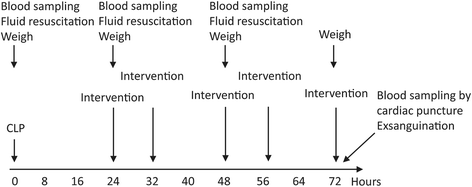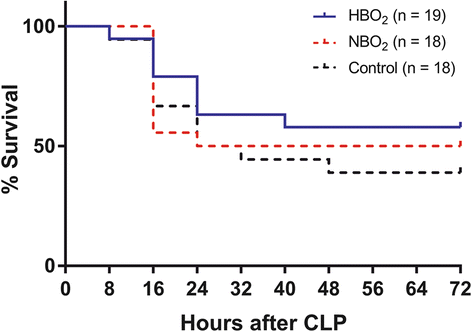Treatment with 24 h-delayed normo- and hyperbaric oxygenation in severe sepsis induced by cecal ligation and puncture in rats
- PMID: 29204105
- PMCID: PMC5702232
- DOI: 10.1186/s12950-017-0173-4
Treatment with 24 h-delayed normo- and hyperbaric oxygenation in severe sepsis induced by cecal ligation and puncture in rats
Abstract
Background: Septic shock remains a leading cause of death worldwide. Hyperbaric oxygen treatment (HBO2) has been shown to alter the inflammatory response during sepsis and to reduce mortality. A therapeutic window of HBO2 treatment has been demonstrated experimentally, but optimal timing remains uncertain. We investigated the effects of 24 h delayed normobaric oxygen (NBO2) and HBO2 treatment on the endogenous production of the inflammatory markers interleukin (IL)-6, tumor necrosis factor (TNF)-α and IL-10, and on mortality in rats with cecal ligation and puncture (CLP) induced sepsis.
Method: Fifty-five male Sprague-Dawley rats underwent CLP and were randomized to the following groups: 1) HBO2 2.5 bar absolute pressure (pabs); 2) NBO2 1.0 bar pabs; 3) Control (no-treatment), and they were individually monitored for 72 h with intermittent blood sampling.
Results: IL-6, TNF-α, and IL-10 were increased 24 h after the procedure, and IL-6 was significantly higher in non-survivors than in survivors. The level of IL-10 was significantly higher at hour 48 in the HBO2 group compared to control (p = 0.01), but this was not the case at other time points. No other significant differences in cytokine levels were found for any group comparisons. Delayed NBO2 and HBO2 treatment failed to change the mortality in the animals.
Conclusion: High levels of IL-6 in non-surviving animals with sepsis suggest that IL-6 is a potential biomarker. We found a significantly higher concentration of IL-10 in the HBO2 group at hour 48 vs. control animals. However, 24 h-delayed treatment with HBO2 did not change the levels of pro-inflammatory cytokines and survival, suggesting that earlier intervention may be required to obtain an anti-inflammatory effect.
Keywords: CLP; Cytokines; HBO2; Inflammation; Mortality; Sepsis.
Conflict of interest statement
Competing interest
The authors declare that they have no competing interests.
Ethics approval and consent to participate
The study was approved by the Danish Animal Experiment Inspectorate (authorization number 2012–12–2934-00504).
Consent for publication
Not applicable.
Publisher’s Note
Springer Nature remains neutral with regard to jurisdictional claims in published maps and institutional affiliations.
Figures


Similar articles
-
Hyperbaric oxygen protects from sepsis mortality via an interleukin-10-dependent mechanism.Crit Care Med. 2006 Oct;34(10):2624-9. doi: 10.1097/01.CCM.0000239438.22758.E0. Crit Care Med. 2006. PMID: 16932233
-
The inhibitor of interleukin-3 receptor protects against sepsis in a rat model of cecal ligation and puncture.Mol Immunol. 2019 May;109:71-80. doi: 10.1016/j.molimm.2019.03.002. Epub 2019 Mar 11. Mol Immunol. 2019. PMID: 30870654
-
Delayed Treatment with Sodium Hydrosulfide Improves Regional Blood Flow and Alleviates Cecal Ligation and Puncture (CLP)-Induced Septic Shock.Shock. 2016 Aug;46(2):183-93. doi: 10.1097/SHK.0000000000000589. Shock. 2016. PMID: 26863032 Free PMC article.
-
The role of hyperbaric oxygen therapy in septic shock: is it time for human studies?Undersea Hyperb Med. 2022 First Quarter;49(1):43-55. Undersea Hyperb Med. 2022. PMID: 35226975 Review.
-
The Mechanisms of Action of Hyperbaric Oxygen in Restoring Host Homeostasis during Sepsis.Biomolecules. 2023 Aug 7;13(8):1228. doi: 10.3390/biom13081228. Biomolecules. 2023. PMID: 37627293 Free PMC article. Review.
Cited by
-
Hyperbaric oxygen treatment is associated with a decrease in cytokine levels in patients with necrotizing soft-tissue infection.Physiol Rep. 2021 Mar;9(6):e14757. doi: 10.14814/phy2.14757. Physiol Rep. 2021. PMID: 33719215 Free PMC article. Clinical Trial.
-
Early hyperbaric oxygen therapy improves survival in a model of severe sepsis.Am J Physiol Regul Integr Comp Physiol. 2019 Jul 1;317(1):R160-R168. doi: 10.1152/ajpregu.00083.2019. Epub 2019 May 15. Am J Physiol Regul Integr Comp Physiol. 2019. PMID: 31091156 Free PMC article.
-
Oxygen therapy for sepsis and prevention of complications.Acute Crit Care. 2022 May;37(2):137-150. doi: 10.4266/acc.2021.01200. Epub 2022 Mar 17. Acute Crit Care. 2022. PMID: 35545238 Free PMC article.
References
-
- Esteban A, Frutos-Vivar F, Ferguson ND, Peñuelas O, Lorente JA, Gordo F, et al. Sepsis incidence and outcome: contrasting the intensive care unit with the hospital ward. Crit Care Med. 2007;35:1284–1289. doi: 10.1097/01.CCM.0000260960.94300.DE. - DOI - PubMed
LinkOut - more resources
Full Text Sources
Other Literature Sources
Miscellaneous

